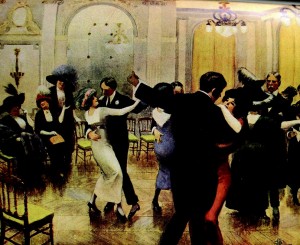So why were men dancing with men? Simply because there were so few women (other than the Ladies of Negotiable Affection) and all of these men yearned to meet a respectable woman, marry her, and raise a family. Since the women had their pick of the men, they looked for the best dancers at social occasions. In the housing conglomerates called conventillos, there were social dances every evening
with musicians, dancers, food, and drink. To stand out and attract a woman, the men learned to dance from other men. This created the traditional learning approach of younger men dancing the female role until they were good enough to dance the male role, and eventually be allowed to actually dance with a woman. In the background, certain women taught the young ladies to dance by assuming the male role and many were very good at doing so. Upper-class rich young men would go slumming to these brothels and these dances. Bottom line is wherever live music was played, men grabbed the opportunity to dance with other men to become better dancers.
In the early 1900’s, these rich young men travelled to France and although Tango was still completely unacceptable in polite society in Buenos Aires, the Parisian upper classes were entranced, and Tango became a massive craze. 1913 was the Year of the Tango all over the world. Tango was the couple dance everyone wanted to learn and fashion changed from Victorian corsets to more open dresses, tango shoes, and tango hats. All of Europe was dancing tango and it quickly crossed the ocean to the Americas. Change happened and such forms as Apache, International Tango, and American Smooth evolved rapidly. The Argentine elite, who had shunned the tango dance of the poor, accepted its now respectable and fashionable incarnation with national pride. Argentina, one of the ten richest nations, had an explosion of tango music, poetry, movies, singers, and culture throughout the 1920’s lasting into the 1950’s – the Golden Age of Tango.
All aspects of Tango were in harmony. Musicians played for dancers. Singers sang as another instrument within the orchestra, rather than as the star. The inspired dancers fuelled an evolution in the dance, and provided the market for the orchestras, encouraging them to compete and create brilliant dance music.
But dark days for tango were about to descend. [More to come]
Patrick Ashby

